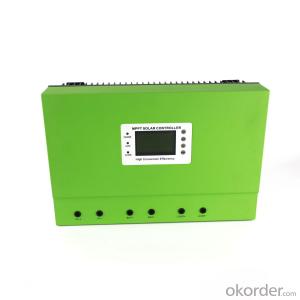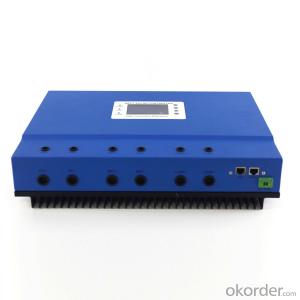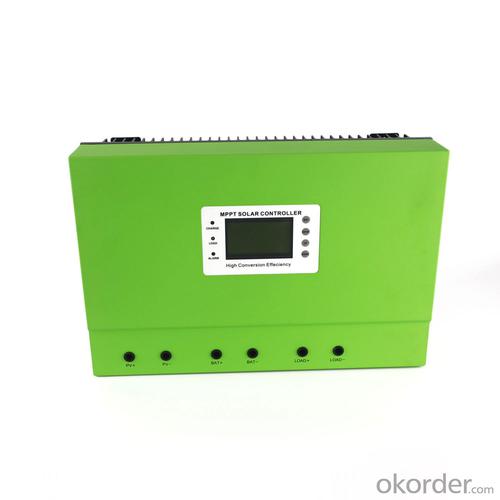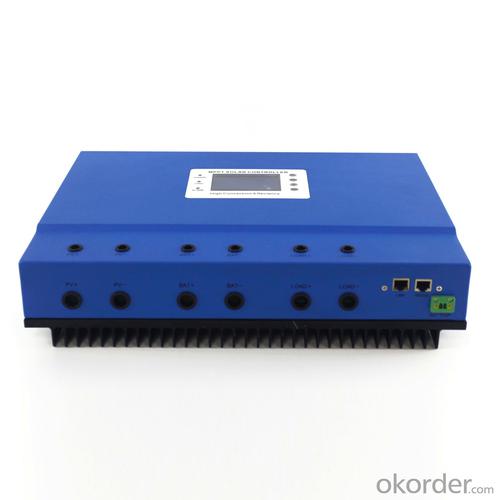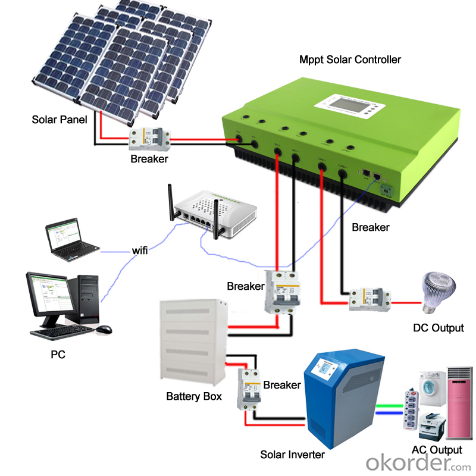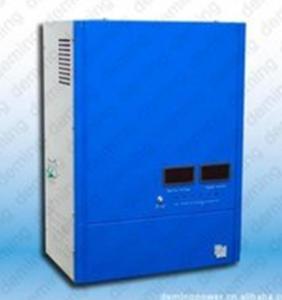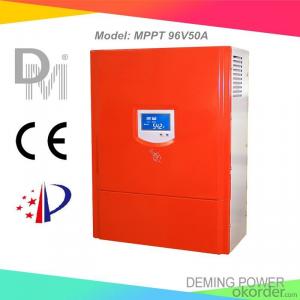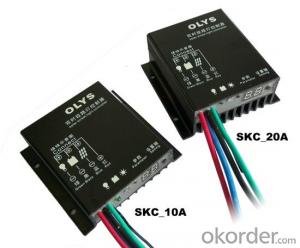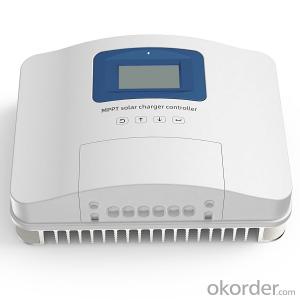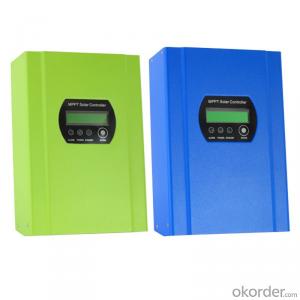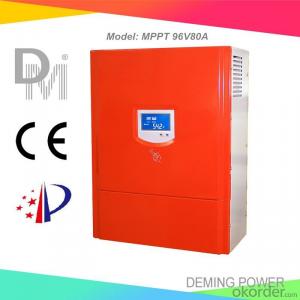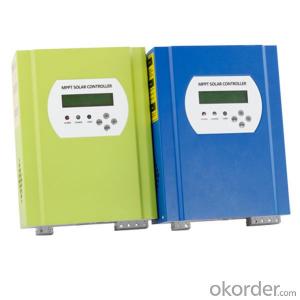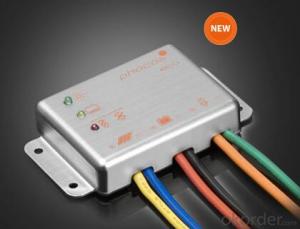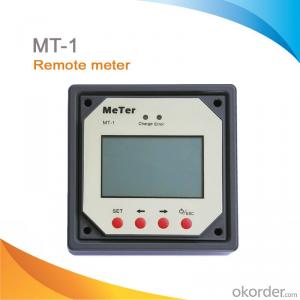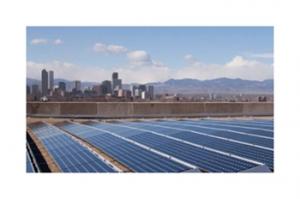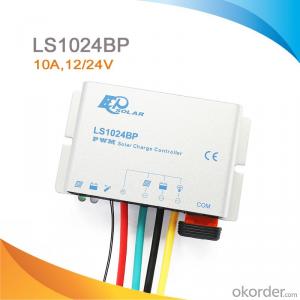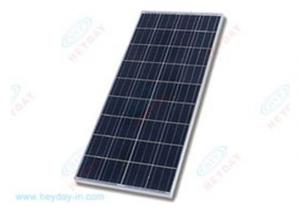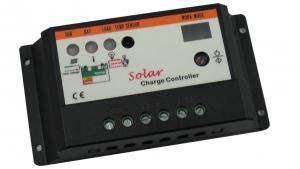Master 80A MPPT solar regulator, 12V 24V 36V 48V charge controller 4000W
- Loading Port:
- China main port
- Payment Terms:
- TT OR LC
- Min Order Qty:
- 10 unit
- Supply Capability:
- 9999 unit/month
OKorder Service Pledge
OKorder Financial Service
You Might Also Like
High efficient MPPT 48v 80a solar charger controller
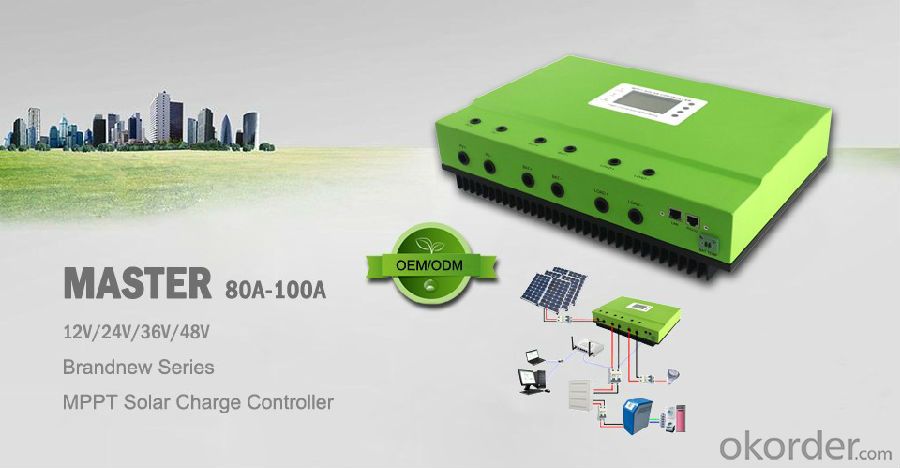
Products Advantages
1. MPPT charge mode,conversion efficiency up to 99%;
2. Maximum PV input is DC 150V;
3. Support all kind of batteries, non-normal type can be set on PC software;
4. Three stage charge mode: fast charge,constant charge,floating charge);
5. With temperature sensor;
6. Anderson connection port, avoide reverse connection;
7. RS232 and LAN communication port, free PC software;
8. Intelligent design,the device can be upgraded online;
9. The devices can suffer the temperature not less than 105°C;
10. Perfect protection:input lowvoltage,input overvoltage,input polarity reversal,
output over voltage,short-circuit over temperature;
11. Unlimited parallel;
12. 5 discharge mode;
13. LCD and LED show all kinds of parameter;
14. CE,ROHS,FCC certifications approved.The device also can support to pass the other certifications;
15. 2 years warranty and 3~10 years extended warranty service also can be provided.
Connection Diagram
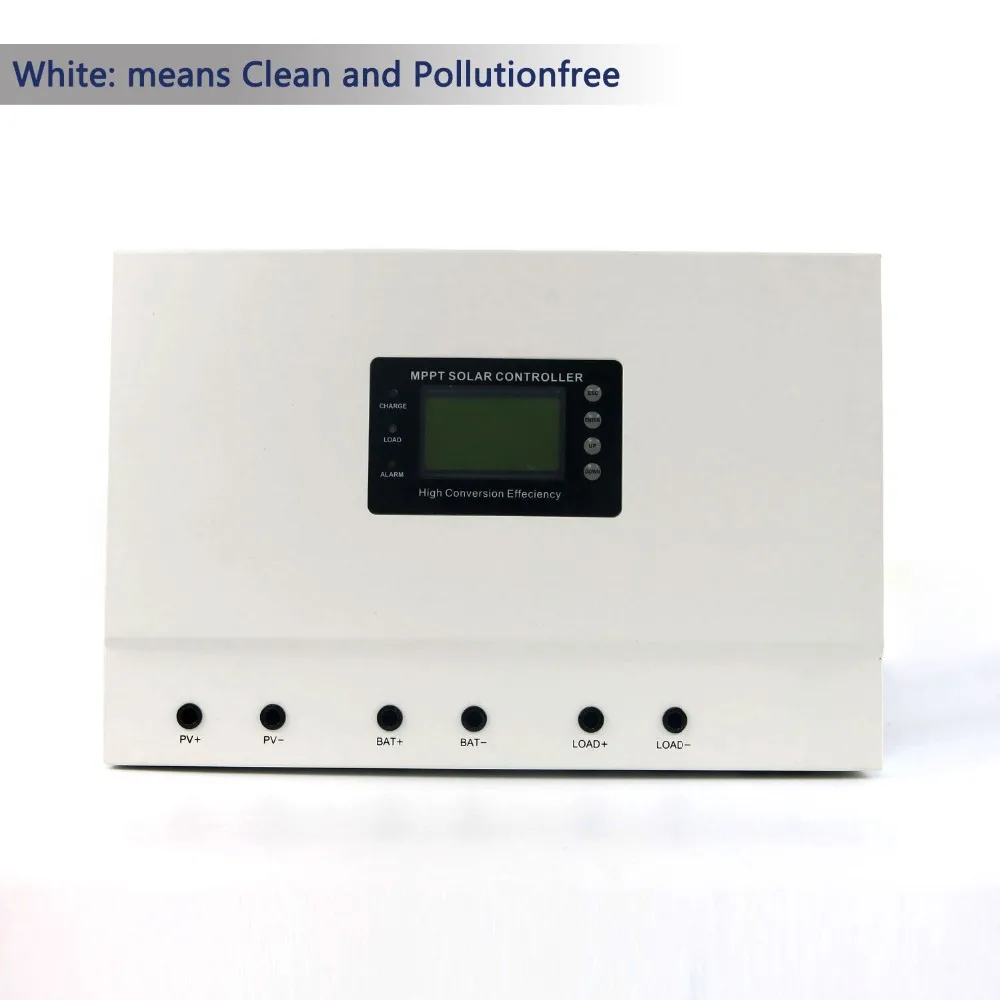
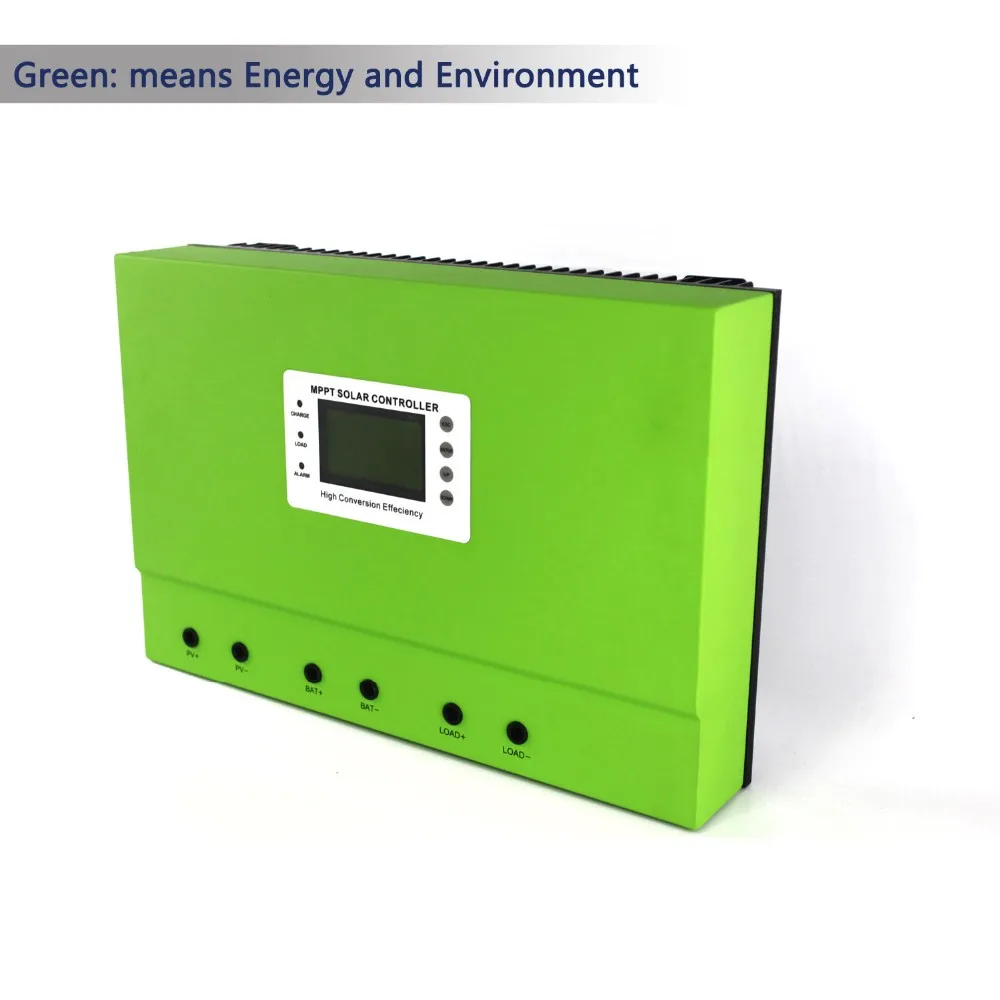
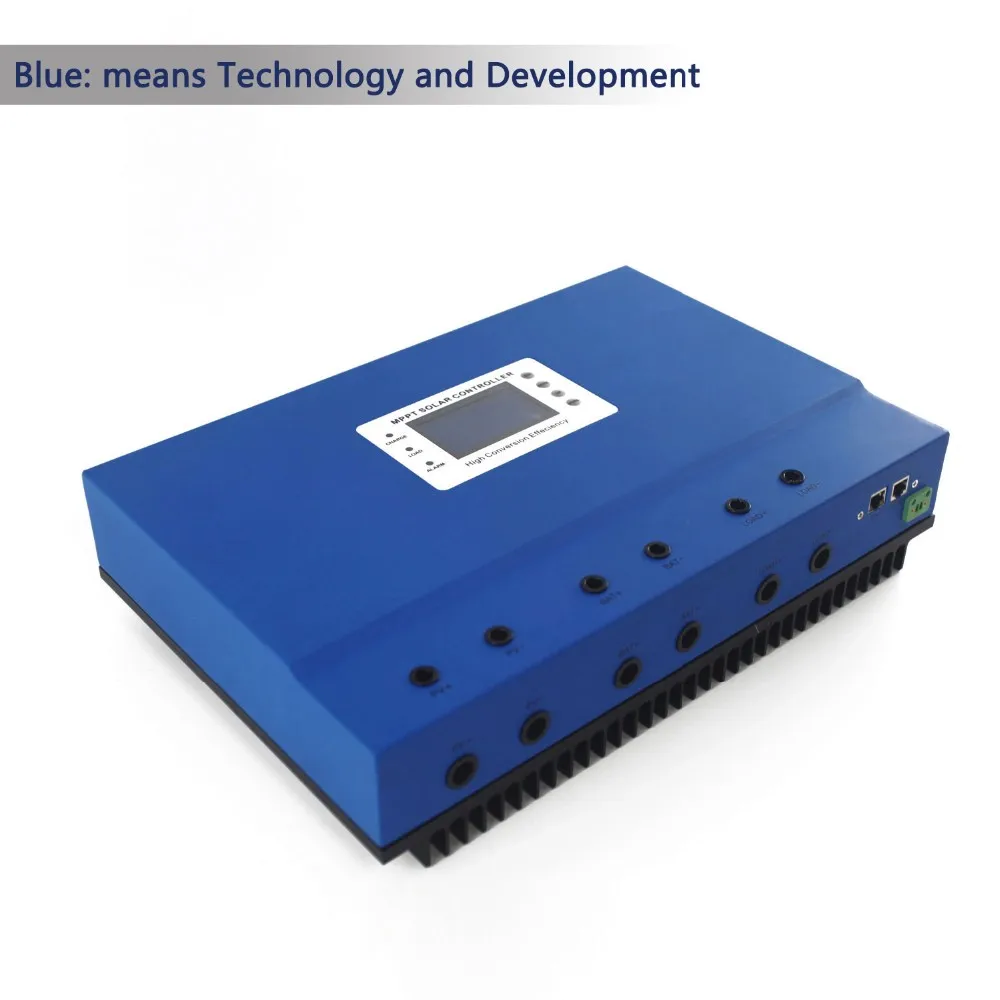
Upper PC Software
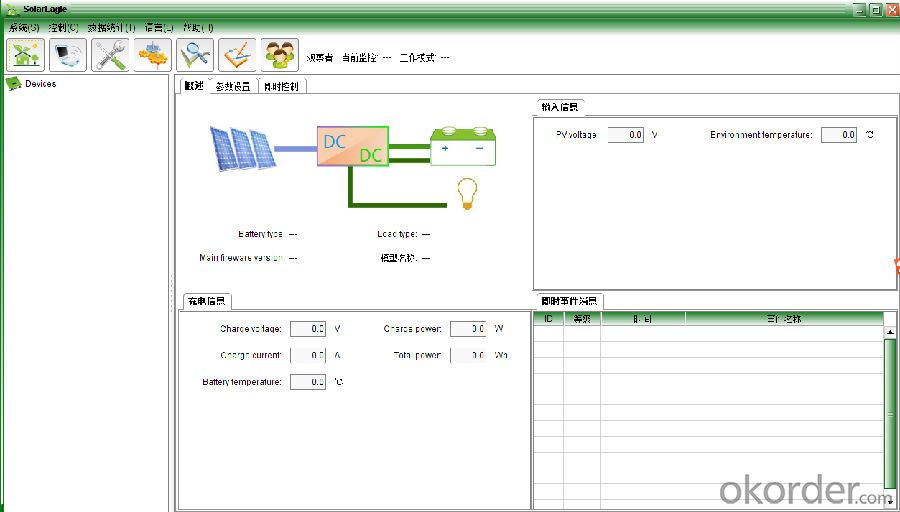
Test Software
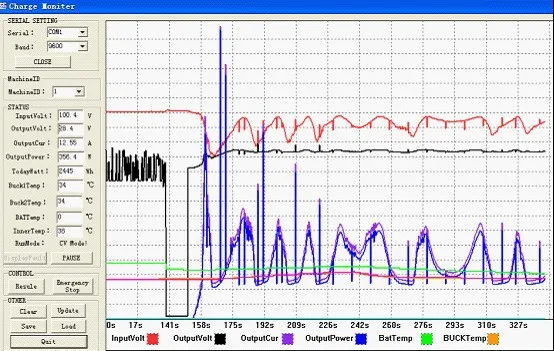
Parameter
MPPT controller Model: Master1-80A/100A Series | 80A | 100A | |
Charge Mode | MPPT(Maximum Power Point Tracking) | ||
Charge Method | 3 stages: fast charge(MPPT),constant voltage, floating charge | ||
System Type | DC12V/24V/36V/48V | Automatic recognition | |
Conversion Efficiency | DC12V/24V/36V/48V | 96.5% ~99% | |
PV Modules Utilization Rate | DC12V/24V/36V/48V | ≥99% | |
PV Input Characteristics | |||
MPPT Working Voltage and Range | 12V system | DC22V~DC150V | |
24V system | DC34V~DC150V | ||
36V system | DC50V~DC150V | ||
48V system | DC60V~DC150V | ||
Input Over voltage Protection Point | DC12V/24V/36V/48V | DC150V | |
Rate charge current | DC12V/24V/36V/48V | 80A | 100A |
Max. PV Power | 12V system | 960W | 1200W |
24V system | 1920W | 2400W | |
36V system | 2880W | 3600W | |
48V system | 3840W | 4800W | |
Charge characteristic | |||
Selectable Battery Types (Default type is GEL battery) | DC12V/24V/36V/48V | Sealed lead acid, vented Gel, NiCd battery (Other types of the batteries also can be defined) | |
Temperature Compensation | DC12V/24V/36V/48V | 14.2V-(The highest temperature-25℃)*0.3 | |
Discharge characteristic | |||
Setting Control | Controller or PC software | ||
Max discharge current | DC12V/24V/36V/48V | 100A | |
Output control mode | Double-time control, ON/OFF mode, PV voltage control, PV&Time control | ||
Physical | |||
Communication Port | RS232 and LAN | ||
Measurement D*W*H (mm) | 420*280*102 | ||
N.G(kg) | 7.5 | ||
G.N(kg) | 8.5 | ||
Color | Blue, Green, White (optional) or OEM | ||
Environment | |||
Humidity | 0~90%RH ( no condense) | ||
Altitude | 0~3000m | ||
Operating Temperature | -20℃ ~ +40℃ | ||
Storage Temperature | -40℃ ~ +75℃ | ||
Atmospheric Pressure | 70~106kPa | ||
Certifications |
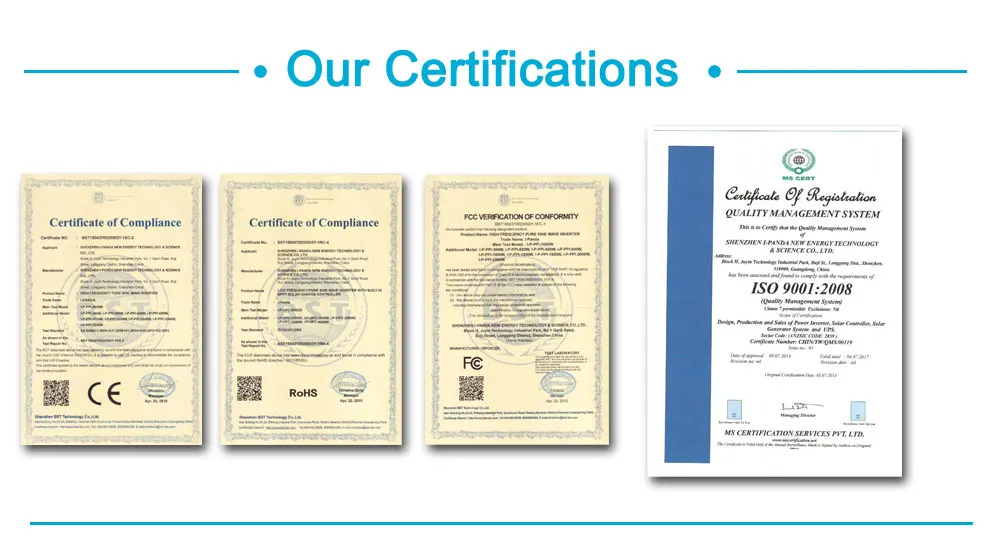
F&Q: |
Q1. How to ensure and monitor the products quality?
A1: We have established a perfect Quality Management System, In strict
accordance with ISO9001: 2008 quality system and ISO14001 environment system for quality assurance management;
Our ISO9001:2008 Quality System certificate encoding: CHIN/TW/QMS/00119;
Our ISO14001 Environment System certificate encoding: CHIN/TW/EMS/00028;
Q2. What is the warranty of products?
A2: The warranty period of different products are different; 5 years, 3 years, 2 years, 1 years; More details please refer to the product specification or manual; we will provide free life-long technical support ;
Q3. What is the difference between MPPT&PWM?
A3. MPPT charging mode, peak efficiency up to 99%, saving 30%~60% solar panel than traditional PWM controller.
- Q: How does a solar controller prevent excessive heating of batteries?
- A solar controller prevents excessive heating of batteries by regulating the charging process. It monitors the battery voltage and temperature, and adjusts the charging current accordingly to prevent overcharging and overheating. This helps protect the batteries from damage and extends their lifespan.
- Q: Can a solar controller be used with solar panels in parallel or series configuration?
- Yes, a solar controller can be used with solar panels in both parallel and series configurations. The purpose of a solar controller is to regulate the flow of energy from the solar panels to the battery or load. It ensures that the battery is not overcharged or damaged by controlling the voltage and current coming from the solar panels. In a parallel configuration, multiple solar panels are connected to the solar controller by wiring the positive terminals together and the negative terminals together. This configuration increases the current capacity of the system while keeping the voltage constant. The solar controller will still regulate the overall voltage and current to protect the battery. In a series configuration, multiple solar panels are connected to the solar controller by wiring the positive terminal of one panel to the negative terminal of the next panel, and so on. This configuration increases the voltage capacity of the system while keeping the current constant. The solar controller will regulate the overall voltage and current to ensure the battery is not overcharged. In both configurations, the solar controller is essential for proper charging and protection of the battery. It monitors the voltage and current coming from the solar panels and adjusts the charging parameters accordingly. Therefore, whether the solar panels are connected in parallel or series, a solar controller is necessary to optimize the charging process and ensure the longevity of the battery.
- Q: Can a solar controller be used with solar-powered electric vehicle chargers?
- Yes, a solar controller can be used with solar-powered electric vehicle chargers. A solar controller is a device that regulates the flow of electricity from solar panels to batteries or other charging systems. It ensures that the charging process is efficient and protects the battery from overcharging or damage. When it comes to solar-powered electric vehicle chargers, a solar controller can be used to manage the charging process and optimize the utilization of solar energy. It helps to regulate the charging speed and maintain the battery's health. By using a solar controller, the charging system can effectively harness solar power and provide a reliable and sustainable charging solution for electric vehicles.
- Q: Can a solar controller be used with a solar-powered spa or wellness center?
- Yes, a solar controller can be used with a solar-powered spa or wellness center. A solar controller is designed to regulate the flow of electricity from solar panels to the batteries or appliances, ensuring optimal energy utilization. In the context of a spa or wellness center, a solar controller can effectively manage the power generated by solar panels, enabling the facility to operate efficiently and sustainably.
- Q: How does a solar controller handle temperature fluctuations?
- A solar controller handles temperature fluctuations by continuously monitoring the temperature of the solar panels or batteries and adjusting the charging parameters accordingly. It uses temperature sensors to detect changes in temperature and modifies the charging voltage or current to ensure optimal charging and prevent damage to the battery or panels. This helps to maximize the efficiency and lifespan of the solar system, even in varying temperature conditions.
- Q: What is the temperature compensation range of a solar controller?
- The temperature compensation range of a solar controller typically refers to the range of temperatures at which the controller can adjust or compensate for the variations in solar panel performance. This range is usually around -40°C to +85°C, allowing the controller to optimize the charging and discharging of the battery in extreme temperature conditions.
- Q: What is the role of a solar controller in preventing battery stratification?
- The role of a solar controller in preventing battery stratification is to regulate the charging process of the battery. It ensures that the battery is charged evenly and prevents overcharging, which can lead to stratification. By monitoring and adjusting the charging voltage and current, the solar controller helps maintain a consistent charge across the battery, preventing the accumulation of acid at the bottom and water at the top. This helps to prolong the battery's lifespan and optimize its performance.
- Q: What is the typical efficiency rating of a solar controller?
- The efficiency rating of a solar controller typically varies depending on the specific model and brand, with most modern controllers having an efficiency rating ranging from 95% to 98%. This indicates their ability to convert 95% to 98% of received solar energy into usable power for battery charging or device powering, while the remaining percentage is typically lost as heat during conversion. It should be noted that factors such as temperature, system voltage, and component quality can affect the efficiency of a solar controller.
- Q: How does a solar controller handle voltage spikes from the solar panels?
- Solar controllers are designed to regulate and control the flow of electricity from solar panels, either to charge batteries or power electrical devices. To handle voltage spikes from the solar panels, the controllers have built-in protection mechanisms. One of the key features of a solar controller is its Maximum Power Point Tracking (MPPT) system. This system constantly monitors and adjusts the voltage and current from the solar panels to ensure maximum power output. By continuously tracking the optimal operating point of the solar panels, the MPPT system helps prevent voltage spikes and reduces the likelihood of voltage fluctuations. Additionally, solar controllers have overvoltage protection mechanisms. These mechanisms are designed to detect and limit any voltage spikes that may occur. When a voltage spike is detected, the controller automatically activates its protective measures to prevent damage to batteries or connected devices. This can involve diverting excess voltage to a dump load or temporarily disconnecting the solar panels from the charging system until the voltage returns to safe levels. In some advanced solar controllers, surge protection devices or transient voltage suppressors may also be incorporated. These components are specifically designed to absorb and dissipate excess electrical energy caused by voltage spikes. By diverting the extra energy away from the system, these devices help protect the controller, batteries, and other connected components from potential damage. Overall, solar controllers are equipped with various protective mechanisms to handle voltage spikes from solar panels. These mechanisms work together to regulate voltage, track the maximum power point, and safeguard the system from sudden voltage surges. This ensures the smooth and efficient operation of the solar power system while protecting its components from potential harm.
- Q: Solar controller can not charge what is the reason the electric power will be less than the inverter with no fixed freezer! Solar energy simply did not charge into the electricity
- Are charged control point voltage: direct charge after the end of the battery will be charged and discharged controller for some time, so that the voltage naturally fall, when the fall to the "recovery voltage" value, will enter the charge state. Why are they designed? That is, when the direct charge is completed, there may be individual batteries "backward" (terminal voltage is relatively low), in order to pull these individual molecules back, so that all the battery side voltage is uniform, so it is necessary to high voltage with moderate Of the current and then charge a small meeting, we can see the so-called charge, that is, "balanced charge." Are charged time should not be too long, usually for a few minutes to ten minutes, the time set too long but harmful. For a small system equipped with two batteries, it is not meaningful. Therefore, the street lamp controller is generally not full charge, only two stages
Send your message to us
Master 80A MPPT solar regulator, 12V 24V 36V 48V charge controller 4000W
- Loading Port:
- China main port
- Payment Terms:
- TT OR LC
- Min Order Qty:
- 10 unit
- Supply Capability:
- 9999 unit/month
OKorder Service Pledge
OKorder Financial Service
Similar products
Hot products
Hot Searches
Related keywords
